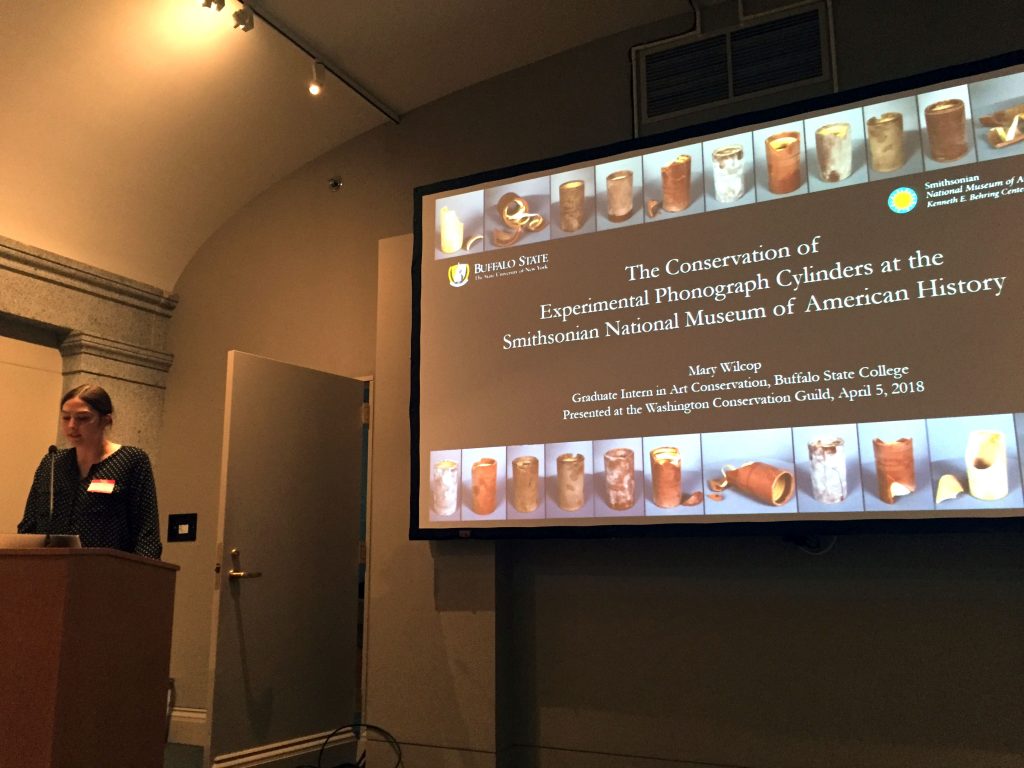Summaries : Intern Talks – Conservation of Early Experimental Phonograph Cylinders at the Smithsonian National Museum of American History
Presenter: Mary Wilcop, graduate fellow in the Buffalo State College art conservation program and third-year intern at the National Museum of American History, Smithsonian Institution
Write up: Claire Valero, Advanced Intern in Paper Conservation at the Library of Congress

Mary Wilcop contributed to the 2018 Intern Talks held at the MacMillan Education Center in the Smithsonian American Art Museum by presenting the treatment of early experimental phonograph cylinders at the Smithsonian National Museum of American History (NMAH). The collection of 26 wax cylinder recordings is part of the Early Sound Recording Collection. She started by presenting the historical background and scientific analysis needed to understand this particular collection, and she finished her presentation by describing her in-progress treatment.
In 1877, Thomas Edison invented the phonograph, the first machine that could record sound and play it back. These recordings were made on tin foil and could sustain replaying only a few times. Improvements were sought to provide better quality and accessibility. As a result, Alexander Graham Bell and the Volta Laboratory came up with the gramophone circa 1887 and Emile Berliner with the experimental gramophone.
The museum’s recording collection has begun to benefit from a noninvasive sound recovery process developed in the Lawrence Berkeley National Laboratory at the Library of Congress. With the IRENE program (Image, Reconstruct, Erase Noise, Etc.), cylinders are scanned, and the 3-D images are transformed into sound files.
Wilcop worked with scientists at the Museum Conservation Institute to conduct materials analysis in order to understand the cylinders’ composition. The composition is likely a mixture of fatty acids and metallic soaps.
The conservation challenges included finding a cleaning method for such a fragile surface and coming up with a repair method for the broken cylinders. A proposed setup for the cleaning experiment was made on a mock-up cylinder, and IRENE scanning was performed on a test piece before and after cleaning. This test is still in process.
The second challenge was the repair method, because the wax was found to be sensitive to all solvents except for water. After several tests on stearic acid pieces, two water-based adhesives were selected: ethyl hydroxyethylcellulose (Ethulose or Bermocoll E 481 C) and methycellulose (Methocel A4M). Because of its slightly less hydroscopic quality, Ethulose was chosen. The adhesive needed to penetrate inside the seam, rather than stay on the surface of the cylinder and possibly alter the texture of the cylinder’s surface. Wilcop constructed a suction mandrel to hold the cylinder pieces together while applying the adhesive. The results look very promising and for the moment one cylinder is cleaned and repaired. The collaboration with the Library of Congress was very fruitful and will continue.